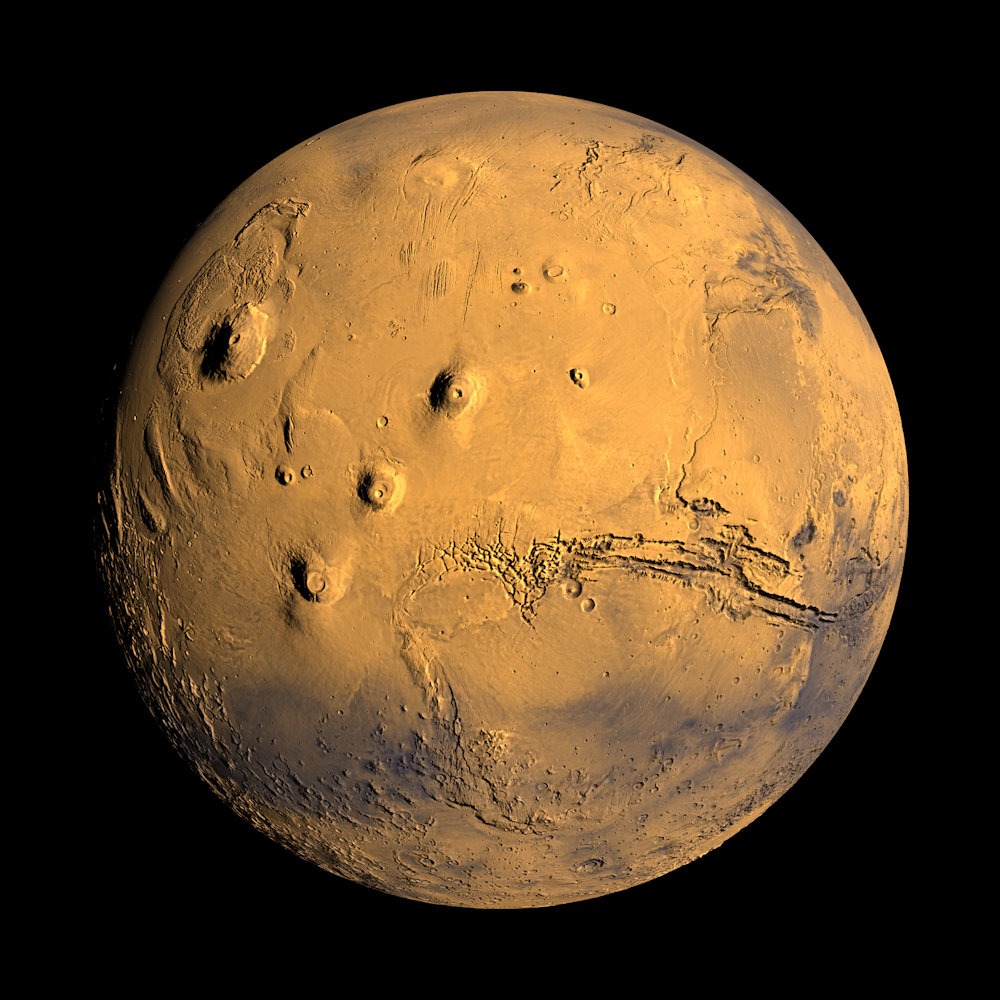Night Sky 2023
Happy New Year to all our readers!
Our first blog of 2023 takes a look at the sky highlights waiting for us in the first half of this year.
We’ll also take a quick look at space missions coming up in that time.
Stellarium
For our night sky images, we’ll use Stellarium.
One of the first things you might do this year is to download it to use for yourself.
Stellarium is superb planetarium software for your PC, smartphone or tablet.
It shows the night sky at any time on any date, present, past or future.
We use Stellarium in Wonderdome.
And its absolutely free of charge!
Download it by clicking here.
Coming up in 2023
January to March
The best constellations are in the south.
The centrepiece is Orion, with three stars in line making the hunter’s belt.
Two bright stars above and below make the main part of this star pattern.
The star at top left is Betelgeuse, a red supergiant star.
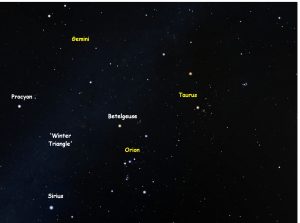
Night sky looking South. Stellarium
Following the line of Orion’s belt up and left brings us to Taurus the bull.
The bull has a glowering red eye, with stars to the left making his two horns.
Orion’s belt then points down and left to Sirius, the brightest star in our night sky.
Above and left of Sirius is Procyon.
Along with Betelgeuse, these stars make a bright ‘Winter Triangle’
Planets
Mars begins 2023 well placed high among the stars of Taurus.
It is distinctly orange and brighter than any of the surrounding stars.
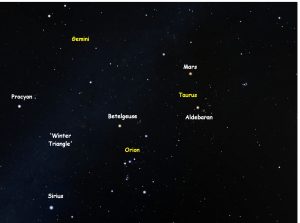
Mars and stars Stellarium

Mars, NASA/JPL
The red planet can be a disappointing planet viewed with a small telescope.
Although it is relatively close, it is a small world.
Air currents in our atmosphere often blur the view.
Patience is the key to observing the red planet.
Wait for the few seconds when our atmosphere stabilises and you will be rewarded with a clearer view.
You may see dark markings in the orange terrain and might even glimpse a polar ice cap.
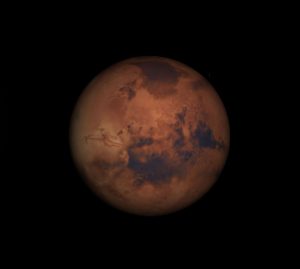
Mars, telescope view. Stellarium
The first time I observed Mars back in the 1970s I saw a featureless orange disc.
I thought that my newly purchased telescope might not be up to scratch.
Then I discovered that a huge dust storm had covered the whole planet!
The best telescopes on Earth saw no more than I had.
The dust settled a few days later and I saw Mars as it should be.
Comet coming!
A comet will call in early this year.
Comet 2022 E3 ZTF will be at its brightest in the final days of January and the early days of February.
It will move across the sky from the north to the east.
At its peak brightness it might be just visible with the naked eye.
However it is more likely you will need binoculars to pick it out in a dark sky.
It will appear as a fuzzy glow, with only a vestige of a tail.
Our finder chart shows where to look for Comet 2022 E3 ZTF.
Look north and find the Big Dipper.
Use a line from the end two stars of the Dipper to the North Star, Polaris.
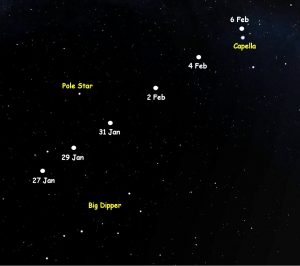
Path of Comet E3 ZTF. Dennis Ashton / Stellarium
In late January the comet will pass between the Dipper and Polaris.
By early February the comet lies between Polaris and the bright yellow star Capella.
By February 6th it is just above Capella.
The comet’s name, E3 ZTF, shows that it was discovered in March 2022 at the Zwicky Transient Facility.
The ZTF is located at Mount Palomar in California.
Stars
Below Mars is the red giant star Aldebaran.
It is orange in colour, like Mars.
In fact its name Aldebaran means ‘rival of Mars’.
It’s nice to see the two contestants so close.
Aldebaran is a huge dying star, some 30 times wider than our Sun.
But in terms of brightness, Mars is the winner.
Whilst Mars is the dominant planet, Jupiter is still on view in the early weeks of 2023.
Going into Spring, the giant world heads resolutely west, setting earlier as the days get longer.
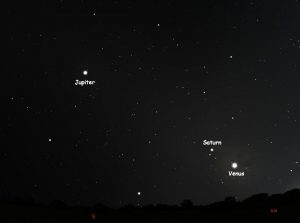
Planets in early 2023. Stellarium
Our Stellarium graphic shows Venus and Saturn close together in the south-west.
On January 22nd, the two planets will be at their closest.
Then on the following night they are joined by a slim crescent Moon.
To see the trio, look southwest as night falls.
And try a photo on your smartphone!
As a bonus, the pairing of Venus and Jupiter happens again on February 15th and the days after.
On February 22nd the Moon joins the party again.
The close encounter of the two planets will continue into the early days of March.
As before look to the south-west after sunset.
Deep Space
I’ve chosen two showpiece deep space objects for this period.
Both can be seen with the naked eye, whilst binoculars give an enhanced view.
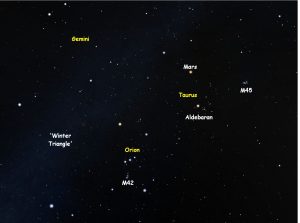
Looking South. Stellarium
First is a star cluster, the Pleiades, Messier Catalogue M45.
The naked eye shows a misty patch of stars.
Binoculars reveal a wonderful group of bright, young blue stars.
The Pleiades are also known as the ‘Seven Sisters’ but you’ll see many more with any optical aid.
Our next target is the Orion Nebula, M42.
This bright gas cloud lies below Orion’s Belt.
With the naked eye, it is a dim misty patch.
Binoculars or a small telescope reveal a fan-shaped cloud of interstellar hydrogen.
April to June
The hours of darkness diminish as we move through Spring to Summer.
But there’s still much to see in the night sky.
We’ll first look at the prominent constellations in the South.
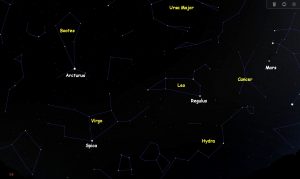
Spring constellations. Stellarium
Stars
The most prominent constellation is now Leo.
The Lion’s head is made of a distinctive ‘reversed question mark’ of stars.
At the bas of the mark sparkles the bright star Regulus.
Left of Leo, the brightest star is Arcturus.
Arcturus is the base of a cone of stars that make Bootes the Shepherd.
Below Arcturus and close to the horizon shines Spica.
This blue star is the brightest member of Virgo, a large spreading pattern of stars.
Planets
Like Jupiter before it, Mars is heading inexorably west and moving further away from Earth.
It has moved from Taurus towards the stars of Cancer.
Venus will now be the dominant planet.
It shines as an ‘evening star’ in the west after sunset, becoming higher as we move into May and June.
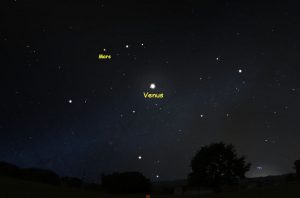
Venus after sunset in the West. Stellarium
Deep Space
Here’s a Springtime challenge.
Can you pick out two rather dim but beautiful constellations?
As ever, Stellarium provides our star chart guide.
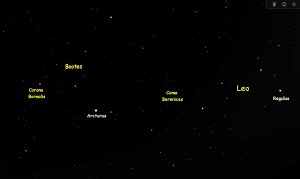
Spring Stars zoom. Stellarium
Our first tiny star pattern is Corona Borealis, The Southern Crown.
This small curl of stars lies to the left of Bootes, marked by bright Arcturus.
Binoculars may help you to pick out this delightful stellar tiara.
Our second target is even more splendid.
It’s a large star cluster, Coma Berenices, the ‘hair of Queen Berenices’.
Coma lies to the left of Leo, between the lion’s head and Arcturus.
This cluster resembles an Eiffel Tower of stars.
You do need a clear, dark sky to see these celestial delights.
Averted vision will help. Look slightly to the side, and the stars look brighter.
The cells in the outer portion of your eye’s retina are more sensitive to dim light.
Good luck with our Springtime challenge!
Shooting Stars
I have noticed over many years of watching the night sky that February is a good month for bright meteors.
For me, along with October, February is fireball time.
Unfortunately these spectacular sights are rare and unpredictable.
However there is a reliable shooting star display in April.
They are the Lyrid meteors, which peak on 22nd and 23rd April’
The best time to look is after midnight.
The Lyrids come from debris left in space by Comet Thatcher, which takes 415 years to orbit the Sun.
It is an ancient meteor display, having been recorded in China some 2,500 years ago.
Space Missions 2023
My highlight of 2023 in spaceflight will be juicy!
JUICE, the European Space Agency’s Jupiter Icy Moons Explorer is scheduled for launch in April.
It will arrive at Jupiter in in July 2031.
Its mission is to take close views of Europa, Ganymede and Callisto.
These ice covered moons, particularly Europa, are thought to house oceans of water.
And where there’s water, there may be life.
April is also the date scheduled for Polaris Dawn.
This is the first Space X mission to take private citizens into Earth orbit.
Four people will travel around our planet in the Crew Dragon capsule.
The mission will be a powerful statement that space is now the province of private companies as well as governments.

Crew Dragon capsule. Photo: NASA
To emphasise this evolution of spaceflight, Space X may launch an even more ambitious programme in 2023.
The dearMoon project aims to take two space tourists around the Moon and back.
This is rather like the unmanned Artemis 1 mission of 2022.
Artemis 1 will be the subject of our next blog.
Watch this Space!
So there’s lots to look forward to in 2023’s night sky.
We hope that you will join us on our Wonderdome journey into space through the year.
The author: Dennis Ashton is a Fellow of the Royal Astronomical Society and a Wonderdome presenter.
Would you like to hear more Astronomy news?
Do you want to to find out about our upcoming public events?
Follow WonderDome Portable Planetarium on Twitter and Facebook or go to our web site wonderdome.co.uk

